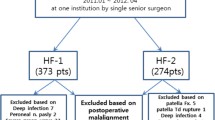Abstract
Range of motion (ROM) is an important outcome variable after total knee arthroplasty (TKA). This may be compounded by a pre-existing fixed flexion deformity (FFD). We therefore examined the long-term outcomes of patients with a flexion deformity undergoing TKA compared to those without a preoperative fixed flexion deformity. Participants who had undergone TKA at our centre between 1989 and 2002 were examined preoperatively, one, five and ten years after TKA (Kinemax PS; Howmedica, Rutherford, NJ, USA). Examining those with a preoperative FFD of greater than ten degrees with complete ten year follow-up data revealed 77 individuals. Seventy seven age, sex and body mass index matched patients were identified and the effect of TKA on indices of knee function (fixed flexion, maximum flexion, total ROM and Knee Society score (KSS) in both groups were analysed using repeated measures ANOVA. A significant difference between the groups with respect to fixed flexion (p < 0.001), total ROM (p = 0.001) and KSS (p < 0.001) was observed between baseline and year one suggesting that those with a preoperative FFD improved more than those without. A significant difference with regard to fixed flexion was also observed between years one to five (p = 0.001) and just failed to reach statistical significance between five to ten years (p = 0.052) between the groups. This study demonstrates that patients with a preoperative fixed flexion deformity show continued improvement in their fixed flexion up to ten years post arthroplasty and have similar outcomes to those with no preoperative fixed flexion.

Similar content being viewed by others
References
Swanson SAV (1980) Biomechanics. In: Aubriot H, Freeman MAR (eds) Arthritis of the knee: clinical features and surgical management. Springer-Verlag, Berlin, pp 1–30
Laubenthal KN, Smidt GL, Kettelkamp DB (1972) A quantitative analysis of knee motion during activities of daily living. Phys Ther 52:34–43
Ritter MA, Campbell ED (1987) Effect of range of motion on the success of a total knee arthroplasty. J Arthroplasty 2:95–97
Callahan CM, Drake BG, Heck DA, Dittus RS (1994) Patient outcomes following tricompartmental total knee replacement. A meta-analysis. JAMA 271:1349–1357
Dennis DA, Komistek RD, Stiehl JB, Walker SA, Dennis KN (1998) Range of motion after total knee arthroplasty: the effect of implant design and weight-bearing conditions. J Arthroplasty 13:748–752
Ritter MA, Harty LD, Davis KE, Meding JB, Berend ME (2003) Predicting range of motion after total knee arthroplasty. Clustering, log-linear regression, and regression tree analysis. J Bone Joint Surg Am 85-A:1278–1285
Tew M, Forster IW (1987) Effect of knee replacement on flexion deformity. J Bone Joint Surg Br 69:395–399
Insall JN, Dorr LD, Scott RD, Scott WN (1989) Rationale of the Knee Society clinical rating system. Clin Orthop Relat Res (248):13–14
Lizaur A, Marco L, Cebrian R (1997) Preoperative factors influencing the range of movement after total knee arthroplasty for severe osteoarthritis. J Bone Joint Surg Br 79:626–629
Tanzer M, Miller J (1989) The natural history of flexion contracture in total knee arthroplasty. A prospective study. Clin Orthop Relat Res (248):129–134
Ritter MA, Lutgring JD, Davis KE, Berend ME, Pierson JL, Meneghini RM (2007) The role of flexion contracture on outcomes in primary total knee arthroplasty. J Arthroplasty 22:1092–1096
Myles CM, Rowe PJ, Walker CR, Nutton RW (2002) Knee joint functional range of movement prior to and following total knee arthroplasty measured using flexible electrogoniometry. Gait Posture 16:46–54
Brosseau L, Tousignant M, Budd J, Chartier N, Duciaume L, Plamondon S, O'Sullivan JP, O'Donoghue S, Balmer S (1997) Intratester and intertester reliability and criterion validity of the parallelogram and universal goniometers for active knee flexion in healthy subjects. Physiother Res Int 2:150–166
Mayerson NH, Milano RA (1984) Goniometric measurement reliability in physical medicine. Arch Phys Med Rehab 65:92–94
Rothstein JM, Miller PJ, Roettger RF (1983) Goniometric reliability in a clinical setting. Elbow and knee measurements. Phys Ther 63:1611–1615
Author information
Authors and Affiliations
Corresponding author
Rights and permissions
About this article
Cite this article
Cheng, K., Ridley, D., Bird, J. et al. Patients with fixed flexion deformity after total knee arthroplasty do just as well as those without: ten-year prospective data. International Orthopaedics (SICOT) 34, 663–667 (2010). https://doi.org/10.1007/s00264-009-0801-6
Received:
Revised:
Accepted:
Published:
Issue Date:
DOI: https://doi.org/10.1007/s00264-009-0801-6




